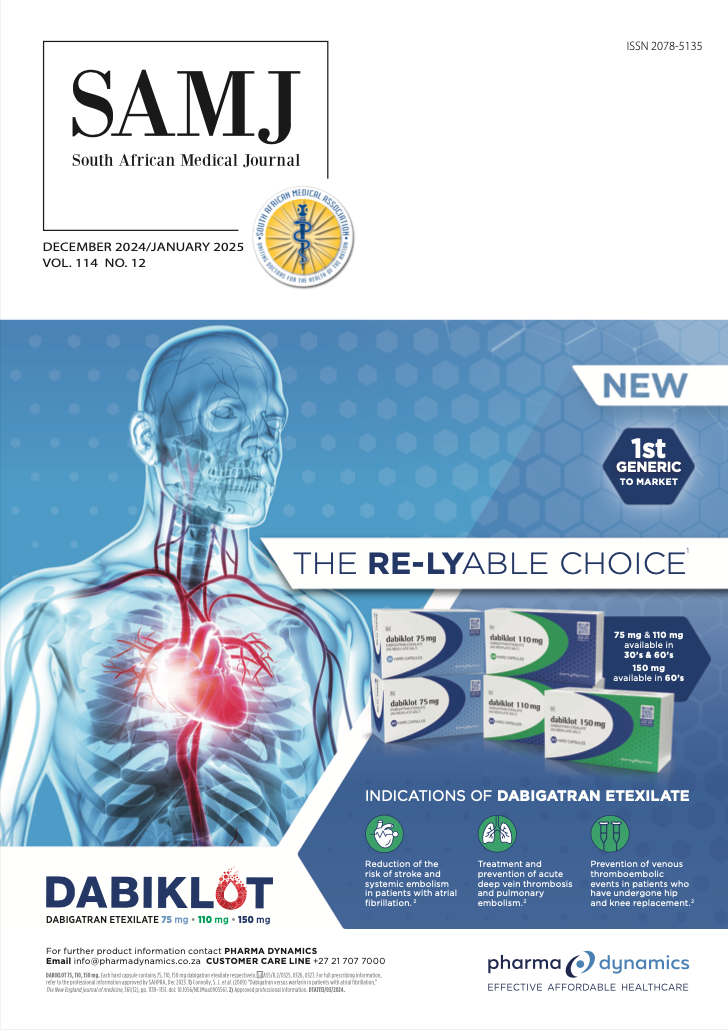Impact of pharmacist-prescriber partnerships to track antibiotic prescribing in publicly funded primary care in the Cape Town metropole, South Africa: An implementation study
DOI:
https://doi.org/10.7196/SAMJ.2024.v114i12.1914Keywords:
Primary care, antimicrobial stewardship, acute respiratory infectionsAbstract
Background. More than 80% of the South African (SA) population receive their care in publicly funded primary care clinics. The majority come from socioeconomically disadvantaged communities, and bear the greatest burden from infectious diseases. However, there are very limited published data on and evaluation of antibiotic prescribing linked to clinical indication. This is a major gap.
Objectives. To assess the impact of a pharmacist-prescriber partnership to track antibiotic prescribing in publicly funded primary healthcare clinics in the Cape Town metropole, SA.
Methods. We conducted a prospective observational study across five clinics where there was a dispensing pharmacist team. At each clinic, a prescriber-pharmacist team gathered prospective antibiotic prescribing data for ‘acute cough’, linked to clinical indication, and provided individual prescribing feedback through each clinic’s WhatsApp messaging platform about their prescribing quality (antibiotic dose, duration, frequency).
Results. Eight out of every 10 patients (adults and children) were prescribed an antibiotic (n=457). In a third of patients, an antibiotic was prescribed for suspected ‘community-acquired pneumonia’. The WhatsApp prescribing feedback was used in half of all visits. The proportion of pharmacy-dispensed antibiotics concordant with local guidelines in terms of prescribing quality was 95% (95% confidence interval 0.93 - 0.98), n=239). Against AWaRe (access/watch/reserve) guidance, 97% of antibiotics prescribed belonged to the ‘access’ group.
Conclusion. Although prescribing concordance with guidelines was good, a significant proportion of patients were prescribed an antibiotic for ‘acute cough’. Our findings have filled a fundamental gap in the evidence base that will inform antibiotic stewardship innovations, guideline development and future interventions.
References
1. Okeke IN, Laxminarayan R, Bhutta ZA, et al. Antimicrobial resistance in developing countries. Part I: Recent trends and current status. Lancet Infect Dis 2005;5(8 ):481-493. https://doi.org/10.1016/s1473- 3099(05)70189-4
2. National Institute for Health and Clinical Excellence. Respiratory tract infections – antibiotic prescribing: Prescribing of antibiotics for self-limiting respiratory tract infections in adults and children in primary care. London: NICE, 2008.
3. Departments of Health and Agriculture Forestry and Fisheries, South Africa. Antimicrobial Resistance National Strategy Framework 2018 - 2024.
4. Chigome A, Ramdas N, Skosana P, et al. A narrative review of antibiotic prescribing practices in primary care settings in South Africa and potential ways forward to reduce antimicrobial resistance. Antibiotics 2023;12(10):1540. https://doi.org/10.3390/antibiotics12101540
5. National Department of Health, South Africa. Essential drugs programme. Standard Treatment Guidelines and Essential Medicines List for South Africa, primary healthcare level. Pretoria: NDoH, 2018.
6. Gasson J, Blockman M, Willems B. Antibiotic prescribing practice and adherence to guidelines in primary care in the Cape Town Metro District, South Africa. S Afr Med J 2018;108:304-310
7. De Vries E, Johnson Y, Willems B, et al. Improving primary care antimicrobial stewardship by implementing a peer audit and feedback intervention in Cape Town community healthcare centres. S Afr Med J 2022;112:812-818. https://doi.org/10.7196/SAMJ.2022.v112i10.16397
8. Van Hecke O, Wang K, Lee JJ, et al. The implications of antibiotic resistance for patients’ recovery from common infections in the community: A systematic review and meta-analysis. Clin Infect Dis 2017;65:371-382. https://doi.org/10.1093/cid/cix233
9. Brink AJ, Messina AP, Feldman C, et al. Antimicrobial stewardship across 47 South African hospitals: An implementation study. Lancet Infect Dis 2016;16:1017-1025. https://doi.org/10.1016/S1473- 3099(16)30012-3.
10. Brink AJ, Messina AP, Feldman C, et al. From guidelines to practice: A pharmacist-driven prospective audit and feedback improvement model for peri-operative antibiotic prophylaxis in 34 South African hospitals. J Antimicrob Chemother 2017;72:1227-1234. https://doi.org/10.1093/jac/dkw523
11. Saha SK, Hawes L, Mazza D. Effectiveness of interventions involving pharmacists on antibiotic prescribing by general practitioners: A systematic review and meta-analysis. J Antimicrob Chemother. 2019 May 1;74(5):1173-1181. https://doi.org/10.1093/jac/dky572
12. Van Hecke O, Butler C, Mendelson M, Tonkin-Crine S. Introducing new point-of-care tests for common infections in publicly funded clinics in South Africa: A qualitative study with primary care clinicians. BMJ Open 2019;9:e029260. https://doi.org/10.1136/bmjopen-2019-029260
13. Van Hecke O, Coetzee R. Establishing a pharmacist-prescriber partnership in publicly funded primary healthcare clinics to optimise antibiotic prescribing in the Western Cape: An exploratory study. S Afr Fam Pract 2020;62(1):e1-e4. https://doi.org/10.4102/safp.v62i1.5090
14. EppsA,AlburyC,vanHeckeO.Exploringprimarycareclinicians’viewsabouthowbesttoimplement a potential trial around point-of-care tests for common infections in South Africa. Diagnostics 2021;11(11):2100. https://doi.org/10.3390/diagnostics11112100
15. Department of Statistics, South Africa. Census 22. Pretoria: Statistics South Africa, 2022. https:// census.statssa.gov.za/#/province/1/2 (accessed 12 December 2023).
16. Mokwele RN, Schellack N, Bronkhorst E, et al. Using mystery shoppers to determine practices pertaining to antibiotic dispensing without a prescription among community pharmacies in South Africa – a pilot survey. JAC Antimicrob Resist 2022;4:dlab196. https://doi.org/10.1093/jacamr/ dlab196.
17. Thompson M, Vodicka TA, Blair PS, et al. Duration of symptoms of respiratory tract infections in children: Systematic review. Br Med J 2013;347:f7027. https://doi.org/10.1136/bmj.f7027
18. Mathibe LJ, Zwane NP. Unnecessary antimicrobial prescribing for upper respiratory tract infections in children in Pietermaritzburg, South Africa. Afr Health Sci 2020;20:1133-1142. https://doi.org/10.4314/ ahs.v20i3.15
19. Lagarde M, Blaauw D. Levels and determinants of overprescribing of antibiotics in the public and private primary care sectors in South Africa. BMJ Glob Health 2023;8(7):e012374. https://doi. org/10.1136/bmjgh-2023-012374
20. Guma SP, Godman B, Campbell SM, Mahomed O. Determinants of the empiric use of antibiotics by general practitioners in South Africa: Observational, analytic, cross-sectional study. Antibiotics 2022;11(10):1423. https://doi.org/10.3390/antibiotics11101423
21. Alabi ME, Essack SY. Antibiotic prescribing amongst South African general practitioners in private practice: An analysis of a health insurance database. JAC Antimicrob Resist 2022;4(5):dlac101. https:// doi.org/10.1093/jacamr/dlac101
22. Ncube NB, Solanki GC, Kredo T, Lalloo R. Antibiotic prescription patterns of South African general medical practitioners for treatment of acute bronchitis. S Afr Med J 2017;107(2):119-122. https://doi. org/10.7196/SAMJ.2017.v107i2.11276
23. Mthombeni TC, Burger JR, Lubbe MS, Julyan M. Antibiotic prescribing to inpatients in Limpopo, South Africa: A multicentre point-prevalence survey. Antimicrob Resist Infect Control 2023;12(1):103. https://doi.org/10.1186/s13756-023-01306-z
24. Almansoori N, Parag N. . Antibiotic prescribing patterns in emergency department at regional hospital in South Africa. Afr Health Sci 2021;21(4):1651-1661. https://doi.org/10.4314/ahs.v21i4.19.
25. Mash B, Fairall L, Adejayan O, et al. A morbidity survey of South African primary care. PLoS ONE 2012;7(3):e32358. https://doi.org/10.1371/journal.pone.0032358
Downloads
Published
Issue
Section
License
Copyright (c) 2024 O Van Hecke, Y Adegoke, M Allwood, K von Pressentin, M Namane, C Butler, M Mendelson, R Coetzee

This work is licensed under a Creative Commons Attribution-NonCommercial 4.0 International License.
Licensing Information
The SAMJ is published under an Attribution-Non Commercial International Creative Commons Attribution (CC-BY-NC 4.0) License. Under this license, authors agree to make articles available to users, without permission or fees, for any lawful, non-commercial purpose. Users may read, copy, or re-use published content as long as the author and original place of publication are properly cited.
Exceptions to this license model is allowed for UKRI and research funded by organisations requiring that research be published open-access without embargo, under a CC-BY licence. As per the journals archiving policy, authors are permitted to self-archive the author-accepted manuscript (AAM) in a repository.
Publishing Rights
Authors grant the Publisher the exclusive right to publish, display, reproduce and/or distribute the Work in print and electronic format and in any medium known or hereafter developed, including for commercial use. The Author also agrees that the Publisher may retain in print or electronic format more than one copy of the Work for the purpose of preservation, security and back-up.





